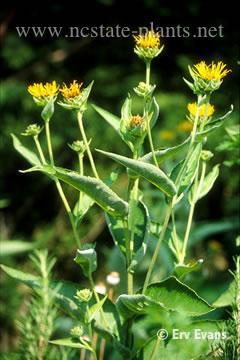Inula helenium
Common Name(s):
- Phonetic Spelling
- IN-yoo-luh hel-EH-nee-um
- This plant has low severity poison characteristics.
- See below
- Description
-
Elecampane is in the Asteraceae (daisy) family and is a very recent introduction to North America. A native of Europe, this perennial weed has been introduced to several nurseries in contaminated hostas and daylilies from the Netherlands. Once introduced, the plant spreads aggressively by thick, fleshy roots that produce new shoots. Plants form rosettes of long, thin leaves that resemble some asters or fleabanes. The leaves also resemble buckhorn plantain leaves except plantain leaves have five distinct parallel veins while Elecamane leaves have netted veins. Leaves remain green through the winter.
Plants require a chilling period to flower. In the spring plants spread rapidly, then in early to mid-summer flowering stems begin to elongate. Plants produce attractive, typical aster-like flowers, yellow to light orange in color. It is unclear whether or not the species produces viable seeds in North America. Because the plant primarily reproduces vegetatively, preemergence herbicides commonly used are not effective. It is nearly impossible to remove all of the root pieces; consequently, if a container plant is infested it should be destroyed before the weed can spread.
Insects, Diseases, and Other Plant Problems: Its weedy tendencies and may cause contact dermatitis in some people.
- See this plant in the following landscape:
- Cultivars / Varieties:
-
- Tags:
- Cultivars / Varieties:
-
- Tags:
-
-
Attributes:
- Genus:
- Inula
- Species:
- helenium
- Family:
- Asteraceae
- Uses (Ethnobotany):
- The root of this plant is used for flavoring the alcoholic beverage absinthe.
- Life Cycle:
- Biennial
- Perennial
- Recommended Propagation Strategy:
- Division
- Seed
- Country Or Region Of Origin:
- Temp. Eurasia
- Dimensions:
- Height: 2 ft. 0 in. - 6 ft. 0 in.
- Width: 2 ft. 0 in. - 3 ft. 0 in.
-
-
Whole Plant Traits:
- Plant Type:
- Wildflower
- Woody Plant Leaf Characteristics:
- Deciduous
- Habit/Form:
- Erect
- Growth Rate:
- Rapid
- Maintenance:
- High
- Texture:
- Coarse
-
-
Cultural Conditions:
- Light:
- Full sun (6 or more hours of direct sunlight a day)
- Available Space To Plant:
- 12 inches-3 feet
- 3 feet-6 feet
- USDA Plant Hardiness Zone:
- 3a, 3b, 4a, 4b, 5a, 5b, 6a, 6b, 7a, 7b
-
-
Fruit:
- Fruit Type:
- Achene
-
-
Flowers:
- Flower Color:
- Gold/Yellow
- Flower Inflorescence:
- Cyme
- Head
- Flower Bloom Time:
- Fall
- Summer
- Flower Petals:
- more than 20 petals/rays
- Flower Size:
- 3-6 inches
- Flower Description:
- Narrow, string-like yellow petals
-
-
Leaves:
- Woody Plant Leaf Characteristics:
- Deciduous
- Leaf Color:
- Green
- Leaf Feel:
- Rough
- Velvety
- Leaf Type:
- Simple
- Leaf Arrangement:
- Alternate
- Leaf Shape:
- Lanceolate
- Leaf Margin:
- Dentate
- Hairs Present:
- Yes
- Leaf Length:
- > 6 inches
- Leaf Width:
- < 1 inch
- Leaf Description:
- Large, rough alternate leaves with a woolly underside.; finely toothed, basal leaves are 10-12 in. long; 1/2-1 in. wide, narrows at the base into long stalks; upper leaves are smaller, stalkless and often clasp the stem by heart-shaped base; densely woolly stems. Leaves have netted veins.
-
-
Stem:
- Stem Color:
- Green
- Stem Is Aromatic:
- No
- Stem Form:
- Straight
- Stem Leaf Scar Shape:
- Heart or shield shaped
- Stem Surface:
- Hairy (pubescent)
- Stem Description:
- Densley woolly
-
-
Landscape:
- Problems:
- Contact Dermatitis
- Weedy










